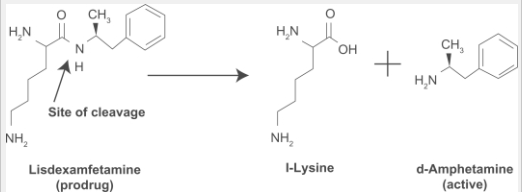
For those of you who are afflicted with ADHD, perhaps the last thing you need is having to remember to take your pills on a schedule; sometimes as often as four times per day. But a little bit of chemistry, aided by your own blood can make your life a little easier; you'll only have to remember once per day. Here's how it works.
Until 2012, the usual choices for treatment of ADHD were ones that you probably know: Ritalin and Adderall (1). Also shown is an infamous drug, "crystal meth."

The thing in the red circle is called a methyl group, hence the name. This seemingly small structural change from Adderall/amphetamine makes methamphetamine about twice as potent as amphetamine (2), and also more addictive. Not surprisingly, all three are Schedule II drugs—the most restrictive category of all legally prescribed drugs (3).
Adderall, although effective in helping ADHD sufferers focus, has its downside. It has to be taken multiple times per day, which results in a "saw-tooth" pattern of blood levels— a rise, followed by a decrease, which may lead to pronounced highs and lows.
In 2012, another option became available. Vyvanse was cleverly designed to overcome some of the liabilities of Adderall. And this new drug also provides a great example of how chemistry and biology can work together to address a problem.
When people take Vyvanse (lisdexamfetamine), they initially do not notice much of an effect. Maybe even none. But then, the drug slowly is converted in the blood into Adderall. The half-life (the time it takes for half of this conversion to take place) is about 3.5 hours. Better still— Vyvanse has no pharmacological activity of its own. It is only after an amino acid called lysine is metabolically removed that it begins to "work." (See figure below)
This effect is reflected the recommended dosage for each drug:
Vyvanse: One capsule in the morning.
Adderall: First dose on awakening; additional doses (1 or 2) at intervals of 4 to 6 hours.
Vyvanse is the quintessential example of a "pro-drug"—an inactive substance that becomes active only after it is absorbed and then metabolized in the body to give the parent drug (4,5). Pro-drugs are better absorbed, taken less frequently, and release the active drug slowly and steadily, which explains why patients who have taken Adderall and switched to Vyvanse often describe the feeling they get as "smoother."
Below is the biochemical reaction that makes this work. The arrow indicates the location of the chemical bond that is broken to release the two components.

Metabolism of Vyvanse- Photo: Neuropsychiatr Dis Treat (2010)
So, if you are one of 8 million adults or 6.4 million children who rely upon medicines to help you concentrate, you can thank chemistry and your blood for making your life a little easier.
Notes:
(1) Methamphetamine (Desoxyn) is an approved drug for ADHD, however it is less commonly used. Strattera (approved 2002) is another choice, but does not apply to the discussion here.
(2) There are small, but insignificant differences between Adderall and amphetamine. For the sake of clarity, I have taken the liberty of considering them to be the same.
(3) Schedule II drugs, according to the FDA have: "a high potential for abuse, [an] accepted medical use in treatment in the United States... [and] may lead to severe psychological or physical dependence."
(4) Another widely used pro-drug is Valtrex, which is a pro-drug of acyclovir. Valtrex is much more readily absorbed than acyclovir and breaks down quickly to give the parent drug. Valtrex is taken once or twice per day. Acyclovir is taken 4-5 times per day.
(5) Pro-drugs are in some ways similar to extended release formulations of drugs, the main difference being that the extended release drug is chemically identical to the standard pills and formulated to slowly release the drug. Pro-drugs are, by definition, chemically different from the parent drug and rely upon the body to do perform the conversion.



